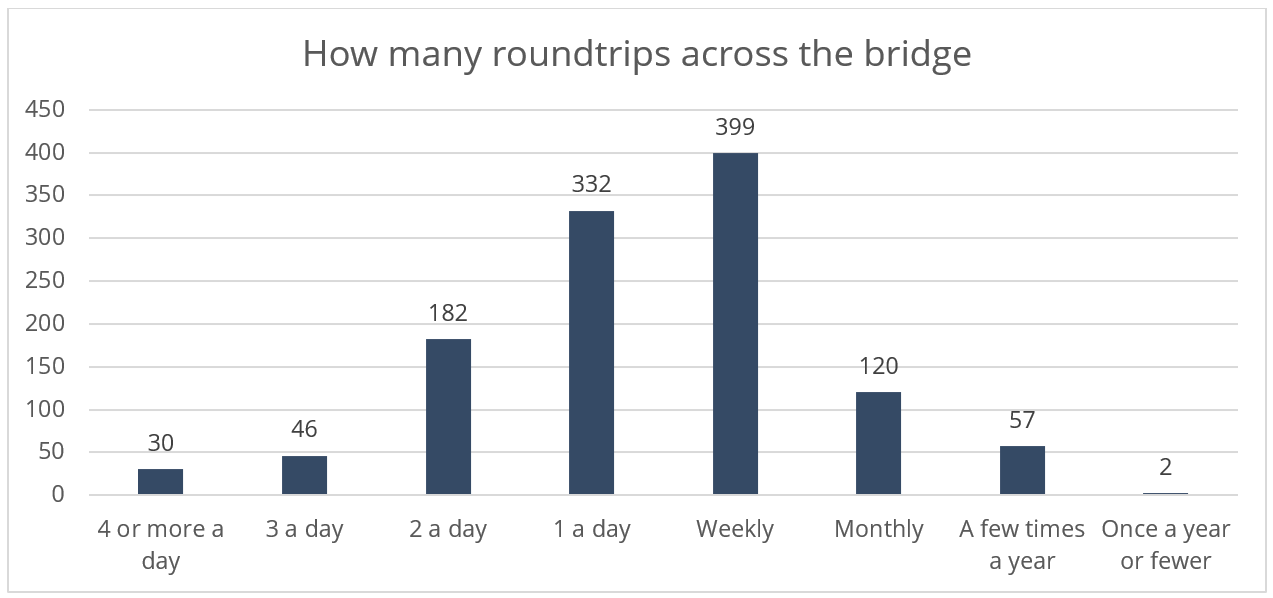Tolling Options Public Feedback – Executive Summary
An expanded summary will be available in the next few weeks.
Tolling open house events
Open house participation:
We received feedback from over 1,250 community members in Washington and Oregon on the two tolling options.
Public preference of tolling options, in pie chart format
· White Salmon (May 31): 143 attendees
· Hood River (June 7): 28 attendees
· Online (May 31-June 14): 1,080 participants
Tolling option preference:
Of the participants who provided feedback on their tolling option preference, 86% chose Option 1 for being the option that best meets the community’s needs.
· Option 1: Online: 893, White Salmon: 82, Hood River: 14 = Total 989
· Option 2: Online: 144, White Salmon: 11, Hood River: 0 = Total 155
Chart of the two tolling options
Comment Themes (in order of most common):
The following comments were received through event comment cards and the online survey.
1. Budget and Funding. Many participants had questions about the bridge replacement funding. Some of these comments were tied to Port of Hood River expenditures (see #2) while many more were around the use of tolls for replacement and when/if tolls would ever be eliminated (see #3). Others wanted to understand the funding mechanisms and get more clarity on what was happening with the project.
· Concerns about managing toll funds in the past. Many expressed confusion about how previous tolls were spent. Many felt they had already paid for the new bridge. Clarity around accounting and previous expenses, for the bridge as well as other Port costs, were requested by many.
· Desire to sell Port property. Multiple people suggested the port sell some of its properties, including its airport, to help pay for the bridge.
· Concern about future tolls. Attendees asked how much the tolls on the new bridge would be, and how long they would be in place after the new bridge was built. Some expressed frustration that they understood the tolls to be temporary. Others requested that there not be tolls at all, or that locals get a steeper discount.
2. Requests for more info. Many people asked for more information on a range of topics, including crossing statistics, clarity on tolls by vehicle types, toll increase timing, maintenance funding and tolls for school buses. Several people requested more information about the overall project schedule.
3. Bridge Design. Many participants had questions or suggestions for the bridge design or functionality. Several would like an aesthetically pleasing, tourist-friendly bridge. Others brought up design considerations related to bike and walking lanes (railing height, wind protection), while others were concerned with the approaches to the bridge and avoiding traffic delays.
4. Support for low-income, disadvantaged or marginalized community members: Several people asked about helping low-income folks with a toll break, either with a subsidy or a sliding scale based on income. Several asked for changes to improve BreezeBy accessibility, for example for people without bank accounts. A few also mentioned reduced or free access for tribal members.
5. Free/improved transit. Multiple people asked for improved public transit, with several asking for a park and ride bus/van to cross the bridge. One asked for connecting bus service to Hwy 141 park and ride.
6. Tolling package suggestions. Several shared suggested toll changes, including toll-free days, phased-in tolling, different rates for locals vs. visitors, discount for retirees or people with low-incomes, and a yearly toll.
· Higher tolls for tourists. Several attendees felt that tourists should pay higher tolls than locals. Several people felt tourists would not notice higher tolls, and higher tolls wouldn’t affect tourist travel across the bridge.
· Higher tolls for freight. Some felt that given the danger trucks pose on the bridge and the increased impact they have on the wear and tear should equate to freight paying more.
· Lower tolls for motorcycles. A few people noticed that the rate for motorcycles seemed disproportionate to their impact on the bridge.
7. Bridge Authority: Comments specific to the new Bridge Authority focused primarily on wanting to see transparent and accountable governance. Information was requested on how members will be appointed and whether there will be any oversight of the Authority.
Participants at the White Salmon open house
How often do you use the bridge?
Chart of how often participants cross the bridge.
What’s the best way to keep you informed about upcoming bridge activities?
Chart of how participants prefer to be informed about the project





